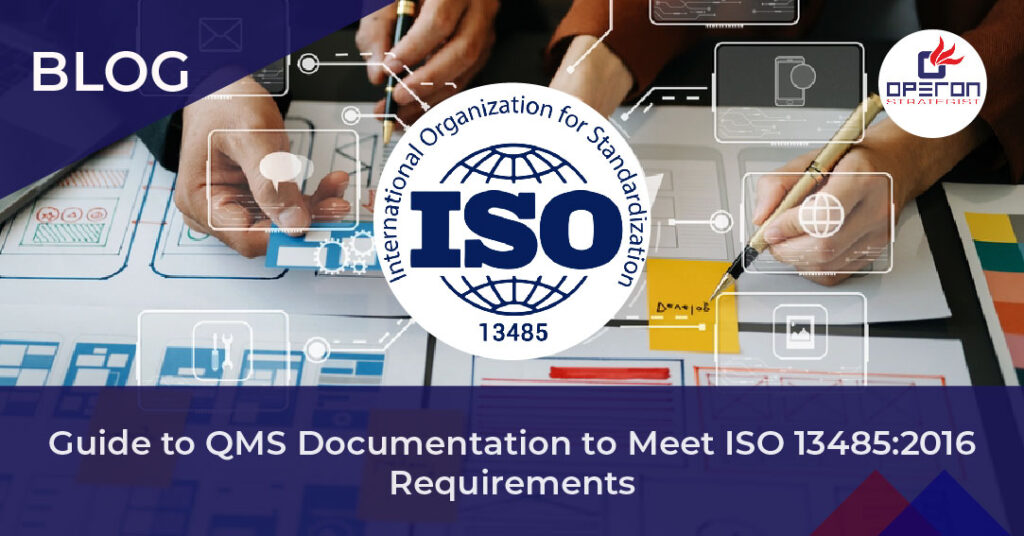Overview of QMS Documentation to Meet ISO 13485
In the medical device industry, compliance with ISO 13485:2016 is essential for organizations aiming to meet global quality standards and ensure device safety and effectiveness. A well-structured Quality Management System (QMS) not only demonstrates regulatory compliance but also builds trust with customers and stakeholders. Achieving compliance with ISO 13485:2016, however, requires a comprehensive approach to documentation, with numerous mandatory procedures and records based on device classifications, target markets, and specific company requirements. This guide provides an in-depth overview of the essential documentation for QMS compliance under ISO 13485:2016, outlining best practices for maintaining a thorough and compliant QMS.
Looking For a Medical Device Regulatory Consultant?
Let’s have a word about your next project
What is ISO 13485:2016?
ISO 13485:2016 is an international standard that specifies requirements for a Quality Management System (QMS) specific to the medical device industry. Organizations that implement this standard must demonstrate an ability to consistently meet customer requirements, adhere to regulatory requirements, and ensure the safe production and delivery of medical devices. The standard covers the entire lifecycle of a medical device, from design and development to production, storage, distribution, and disposal.
Why QMS Documentation is Crucial for ISO 13485:2016 Compliance
Documentation is a key component of ISO 13485:2016 compliance. It provides the evidence needed to verify that an organization’s processes are consistent, controlled, and capable of delivering quality medical devices. Proper documentation also serves as a foundation for audits and inspections, helping organizations prepare for both internal and external quality assessments.
Key documentation objectives under ISO 13485:2016 include:
- Defining standard operating procedures (SOPs)
- Documenting work instructions and workflows
- Demonstrating compliance with regulatory requirements
- Providing evidence for corrective and preventive actions (CAPA)
List of Mandatory Documents for ISO 13485:2016 Compliance
ISO 13485:2016 outlines several mandatory documents and records that must be maintained by any organization operating under this standard. Here is a breakdown of the primary documentation required for a compliant QMS:
1. Quality Manual
- The Quality Manual is the cornerstone document of the QMS. It provides an overview of the organization’s quality management structure, policies, and objectives. It includes details on processes, scope of QMS, and how each requirement of ISO 13485:2016 is addressed within the organization.
- Tip: Ensure the Quality Manual is kept up to date with all regulatory requirements relevant to your target markets.
2. Quality Policy and Objectives
- The quality policy outlines the organization’s commitment to quality and serves as a guide for all personnel. Quality objectives set measurable targets aligned with the quality policy to ensure continuous improvement.
- Best Practice: Regularly review quality objectives to align with evolving industry standards and market demands.
3. Design and Development Documentation
- Documentation for design and development includes planning, inputs, outputs, reviews, verification, validation, and changes. This section is crucial for ensuring that medical devices are safe, effective, and meet user needs.
- Key Records: Include risk management reports, design validation plans, and user needs assessments.
4. Risk Management Documentation
- ISO 13485:2016 requires a robust risk management process throughout the product lifecycle. Organizations must document risk assessments, risk control measures, and risk/benefit analyses in compliance with ISO 14971 (Application of risk management to medical devices).
- Key Records: Risk analysis, risk control planning, and residual risk evaluation.
5. Product Realization Documentation
- This includes records of processes used to bring a device from design to market, such as production and process controls, purchasing records, and traceability.
- Tip: Incorporate traceability systems for components, materials, and production records to meet regulatory requirements.
6. Documented Procedures and SOPs
- ISO 13485:2016 mandates specific SOPs for processes such as document control, CAPA, internal audits, management reviews, and more. SOPs ensure that each process is performed in a consistent manner.
- Best Practice: Establish a document control process to ensure timely updates and controlled access to SOPs.
7. Validation and Verification Records
- Validation and verification are essential steps to confirm that the product meets design specifications and intended uses. These records serve as proof that the device functions safely and effectively.
- Tip: Maintain clear and thorough records for each validation and verification process, as these are often closely reviewed in audits.
8. Supplier Management and Purchasing Documentation
- Supplier quality management is critical in ensuring that materials and components meet the required standards. Documentation should include supplier qualification, quality agreements, and records of purchased products and services.
- Key Records: Approved supplier lists, purchasing records, and supplier audits.
9. Corrective and Preventive Actions (CAPA) Records
- CAPA documentation captures how the organization handles nonconformities and identifies preventive measures to avoid reoccurrence. This documentation is fundamental to the continual improvement aspect of the QMS.
- Tip: Ensure all CAPA records are well-organized and easily accessible for review during audits.
10. Internal Audit and Management Review Documentation
- Organizations are required to perform regular internal audits to assess compliance and the effectiveness of the QMS. Management reviews assess the performance of the QMS, identifying opportunities for improvement.
- Best Practice: Schedule audits and management reviews at regular intervals, maintaining records of each review, findings, and follow-up actions.
Best Practices for QMS Documentation
- Implement a Digital Document Control System
To manage extensive documentation efficiently, consider a digital document control system. It allows easy access to documents, enhances version control, and reduces the likelihood of lost or outdated files. - Conduct Regular Training
ISO 13485:2016 requires that personnel be competent for tasks affecting product quality. Regular training ensures that team members are familiar with QMS documentation requirements and understand their role in maintaining compliance. - Stay Current with Regulatory Changes
Medical device regulations evolve, and so should your documentation practices. Regularly reviewing updates in regulatory requirements ensures your QMS remains compliant with industry standards.
Need Assistance With ISO 13485:2016 QMS Documentation?
Operon Strategist: Your Partner in ISO 13485:2016 Compliance
Operon Strategist provides comprehensive support for medical device manufacturers to achieve ISO 13485:2016 compliance. With our expertise, we assist in setting up and maintaining a Quality Management System (QMS) that aligns with regulatory requirements. Here’s how we help:
- QMS Documentation: We organize essential documents—Quality Manuals, SOPs, and work instructions—ensuring regulatory standards and audit readiness.
- Design Compliance: Our team supports design documentation for risk management and validation, aligning with ISO 14971.
- Risk Management: We help implement robust risk processes to identify, document, and control potential hazards.
- Audits & CAPA: From internal audits to CAPA processes, we establish proactive systems for nonconformity management.
- Supplier Management: Operon ensures quality supplier qualification, monitoring, and audit documentation for a reliable supply chain.
- Training: Our training programs cover standards, QMS maintenance, and audit prep to enhance team competence.
- Digital Document Control: We facilitate the transition to digital QMS systems for efficient document management and version control.
- Certification Prep: We guide clients from audit readiness to ISO 13485 certification, focusing on continuous improvement.
Let us be your trusted partner in ISO 13485:2016 compliance. Contact Operon Strategist today and learn how we can support your journey toward QMS excellence and regulatory success.
- adminhttps://operonstrategist.com/author/admin-2/
- adminhttps://operonstrategist.com/author/admin-2/
- adminhttps://operonstrategist.com/author/admin-2/
- adminhttps://operonstrategist.com/author/admin-2/



